
by John P. Pratt
22 May 2013 (1 Reed, Sacred Round)
©2013 by John P. Pratt. All rights Reserved.
| 1. The Week |
| 1.1 Seven-Day Cycle |
| 1.2 Moses and Manna |
| 1.3 Priest Calendar Counts Weeks |
| 2. The Uniform Enoch Year |
| 2.1 52 Weeks Per Year |
| 2.2 Four Identical Quarters |
| 3. Align Sacred Calendars |
| 3.1 Align with Priest Calendar |
| 3.2 Align with Trecena |
| 3.3 Align with Veintena |
| 3.4 Start 0 Spring on 13 Monkey |
| 4. New Results |
| 4.1 Correction |
| 4.2 Jesus Christ |
| 4.2.1 Presentation to Priest |
| 4.2.2 Begin Public Ministry |
| 4.2.3 Resurrection |
| 4.3 Adam & Eve |
| 4.4 Enoch & Ordinations |
| 4.5 Noah |
| 4.6 Joseph & Joseph |
| 4.7 Moses |
| 4.8 David & Solomon |
| 5. Conclusion |
| Notes |
After the last article on the Uniform Venus Calendar, it seemed appropriate to re-examine the Uniform Enoch Calendar (formerly called the "Enoch Fixed Calendar"[1] in my articles). That has remained unchanged for many years and has not been questioned. As a detailed study was done, analyzing hundreds of historical dates, it became clear that one minor adjustment needs to be made. This article develops that calendar from first principles. Then the needed adjustment to the prior version is noted and the powerful new results are discussed. Because one cornerstone of the Enoch Calendar is the 7-day week, let us begin by examining the week in some detail. Readers who wish to avoid tedious calendar derivation details may skip to Section 4 which summarizes new results.
The week is a simple day count that just keeps counting days by sevens over and over. It is never adjusted to fit the phases of the moon or length of the year. In 1582, when an error was discovered in the yearly calendar, it was corrected by dropping 10 days from October that year. The day Thu 4 Oct 1582 (on the Julian Calendar) was followed the next day by Fri 15 Oct 1582 (on the new Gregorian Calendar that we still use). That led to law suits about rent, etc., but notice that Thursday was followed by Friday. The week went on independently and was untouched, as if nothing had happened. It is just a simple, continuous, on-going cycle of seven days independent even of the rest of the calendar it seems to be part of. Let us look more closely at the week and then see how the Uniform Enoch Calendar is one way to keep track of weeks.
 |
Look again at Figure 1. Notice that the Sundays are shown in red. It is apparently a calendar for Christians, who believe that the first day of the week is holy because that is the day on which Jesus overcame death by resurrecting. In a way we are celebrating Easter Sunday every week just by worshipping on that day! Before that, the Lord's people worshipped on the seventh day, which we call Saturday. That was because the Lord told Moses that He created the earth in seven days and rested on the seventh, and so should they. But there is evidence that at the resurrection of Christ the day of worship for His followers changed to be the first day of the week. That was the day on which they met to keep the sacrament of the Lord's Supper, which they called "breaking bread" (Acts 20:7).
To the best of my recollection, wall calendars many decades ago nearly all had Sundays shown in red. As this article was being prepared, it was very difficult to find any illustration of a calendar with red Sundays. There have been many subtle changes to our culture which delete Christian symbols and reminders and that seems to be one of them.
How accurate has the 7-day count been? That is, has the count ever been altered? Is the day Sunday on our calendar the same as Sunday back at the time of Jesus?
There are at least two ways to answer that question and they both agree. One is that about six hundred years before Jesus, the Lord's people had forgotten to be careful about keeping the sabbath (seventh day) and the Lord punished them for seventy years, a number related to how many Sabbaths had been missed. They (the Jews) learned their lesson and have been very careful ever since never to miss a day. In all of my research, there is no evidence that since those seventy years that even one day has ever been miscounted. We can thank them for that and then the Christians afterward who also have fought to keep the count correct.
The second answer is that in modern times the Lord confirmed two things and implied a third: 1) that Sunday is the correct day to worship, 2) that He calls it "the Lord's day", and 3) if our Sunday is indeed the correct day to worship, it supports the evidence that Sunday has not changed over the years. On Sunday, 7 Aug 1831, He said to the Prophet Joseph Smith:
"For verily this is a day appointed unto you to rest from your labors, and to pay thy devotions unto the Most High; ... remember that on this, the Lord's day, thou shalt offer thine oblations and thy sacraments unto the Most High, confessing thy sins unto thy brethren, and before the Lord" (D&C 59:10).
When did counting weeks of seven days and keeping the sabbath (seventh) day begin? The fourth of the Ten Commandments is "Remember the sabbath day, to keep it holy" (Exo. 20:8). But how long before that did men know about resting on the seventh day?
To the best of my knowledge, the answer according to what is recorded in the Bible turns out to be only three weeks before the Ten Commandments were given!
There is no record in all of the book of Genesis that any of the patriarchs before the Great Deluge, or even up to Abraham, Isaac and Jacob, kept a sabbath day. They might well have done that, but it just didn't get put into the Bible.
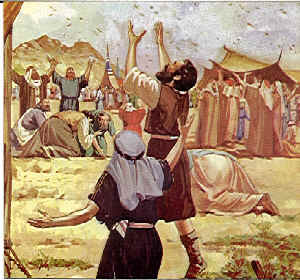 |
Now let's briefly look at one calendar which keeps track of weeks.
Is there a way to keep track of what week it is, or to count weeks? The subject of this paper is the Uniform Enoch Calendar. It is based on the week, but does not appear to be designed just to count weeks. Because it is very closely integrated with another calendar which does count weeks, let us look briefly at the Priest Calendar.
When the Temple of Solomon began to function, a ritual was instituted which is an excellent way to count weeks. Twenty-four families of priests were chosen to each take turns officiating in the temple for exactly one week. It was also an eternal cycle, which was a method to bundle weeks in sets of 24, naming each week after the priestly family officiating. My work refers to this cycle as the Priest Calendar, even though it is not called such anywhere else to my knowledge. There are enough explicit, precise records from history to know exactly what any day in history is according to the Priest Calendar.[2]
The two things important to understand for this current article are first that the Priest Cycle counts weeks in groups of 24, for a total of 7 x 24 = 168 days per cycle. That is also the number of hours in a week, that is, 24 hours x 7 = 168 hours.
Second, the Priest Cycle begins on Saturday (at noon). That may be extremely important because many calendar units are named for the "zeroth" day of the cycle. The names of each Priest family provide names for each week.
 |
With that background as a foundation, let us now turn to understanding the structure of the Uniform Enoch Calendar.
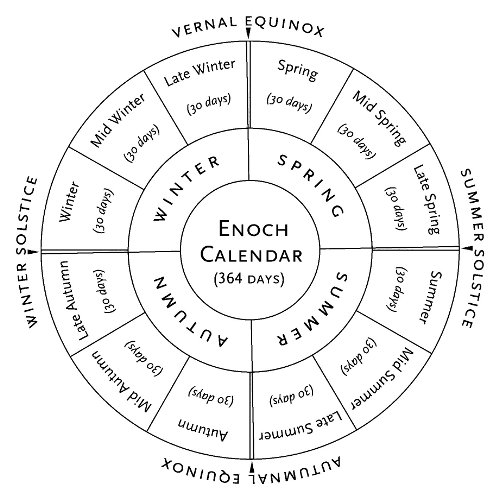 |
That yields a pattern of 364 days (12x30 + 4 = 364). That turns out to be exactly 52 weeks (52 x 7 = 364). That is noticeably short of the true 365.24 day year. The big difference between the Uniform Enoch (UE) and the Enoch (E) versions is that in the uniform version no extra weeks are ever intercalated (inserted) to keep the calendar actually aligned with the sun. That means the UE Calendar does not actually track the sun at all. Instead, it collects weeks into groups of 52 that fit a pattern of the four seasons.
It is important to understand several things about this calendar. Because it does not track the actual seasons, a day in the middle of summer might be called 0 Winter (the winter solstice). Another point is that many of the holy days follow the same pattern as the Hebrew calendar, such as Passover (14 Nisan, the first month of spring) corresponding to 14 Spring (E and UE). As with the Hebrew Calendar the first day of each month (such as 1 Summer) is a holy day, but in addition all of the zero days of the four quarters are also holy days.
A third important concept is that the pattern is constant and unchanging (hence "uniform"). Once one single day is chosen to begin the calendar (on 0 Spring), all other days throughout history are determined. That is the power of this calendar. It will turn out that many more dates in history fall on "holy days" on this calendar than would be predicted by chance. That provides a strong statistical witness of the hand of God being involved. Moreover, a day with "Passover" symbolism can fall in any season of the year, rather than only in spring.
Another powerful feature of this calendar is that all four seasons fit the identical pattern. That is, they begin on a day "zero" followed by three months of days numbered 1 to 30. The month names, chosen by this author as they are not given in the Book of Enoch, follow the pattern of "Spring", "Mid Spring" and "Late Spring" (or Summer, Autumn, or Winter). The Book of Enoch makes it clear that the first day of the year is on 1 Spring. Let us now see how this pattern is ideally chosen to align with three other sacred calendars.
What is the one day in history on which to begin the Enoch Calendar? Over a decade ago when this calendar was being discovered, my approach was strictly empirical, to see what start date would maximize the largest number of known historical dates to fall on holy days. That was difficult when all four quarters of the calendar were identical. The choice was principally chosen to align one holy day which falls only in one quarter: Firstfruits (or Pentecost), which falls on 4 Late Spring, having no corresponding holy day in any other quarter. Choosing such an alignment resulted in two compelling results: first, it aligned the calendar with the Enoch Calendar during the Savior's ministry. The two calendars (UE and E) only align for about five years every 293 years. Because the Savior is the center of all things, that seemed like an excellent choice. Secondly, by choosing the two calendars to align during those years, several sacred events of history fell on Firstfruits on this calendar. Those were strong witnesses and have not been questioned until now.
Since that time the Uniform Jubilee Calendar has been discovered, which also has 364 days every year. The alignment chosen for it was also to align that same holy day (Firstfruits) with the Uniform Enoch Calendar. That means that any event that falls of Firstfruits on one calendar would always occur on Firstfruits on the other too. In retrospect, it now appears that the holy days that appear to offer evidence favoring aligning the Uniform Enoch calendar really were for the Uniform Jubilee Calendar. Moreover, the importance of aligning during the Savior's ministry was diminished in last month's article about the Uniform Venus Calendar. There it was seen that the alignments were on vital dates for the seven chief angels of the Lord rather than during His lifetime.
Thus, with both of the strongest reasons for the former choice in question, let us start from scratch with entirely different criteria. Let us choose by aligning the UE Calendar with three other sacred calendars. It turns out that making that choice results in many more occurrences of sacred events on holy days on the UE calendar than formerly. So it is a win-win method and hopefully will never need future modification.
Each season of the Uniform Enoch Calendar contains exactly 13 weeks (4 x 13 = 52). So this calendar is all set up to fit exactly into patterns of weeks.
How should a calendar begin where every quarter of the year begins on the same day of the week? It might seem obvious that every quarter should begin on a Sunday, so that the first day of the week and the first day of each quarter line up. That is, that 1 Spring would always be on a Sunday.
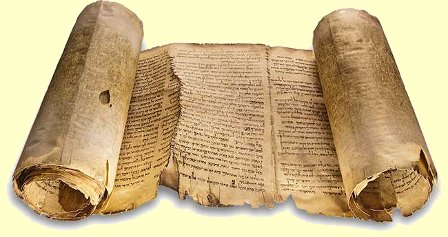 |
As this question was revisited in this current update, as in my earlier work, the obvious choice of Sunday again won out over the Qumran choice of Wednesday. The Uniform Enoch Calendar should be aligned with the week so that the first day of each quarter (such as 1 Spring) is a Sunday. That makes the seasonal marker days (like 0 Spring) all fall on Saturday.
Thus, this is the first alignment chosen: to align with UE Calendar with the week, and hence with the Priest Calendar. Note that the holy day on the Priest Calendar (the first day of their seven day service), as far as is now known, falls half on what we now call Saturday (noon-midnight) and half on Sunday (midnight to noon).
Is there any special Saturday on the Priest Calendar that should line up with 0 Spring on the UE calendar? One way to answer that is to ask if all weeks of the Priest Calendar would have an equal chance to be 0 Spring. The answer is no for the following reason. The priest cycle is 24 weeks long and the UE is 52 weeks long. So after 48 weeks into a year, the priest cycle is back to the beginning place. Then the next year will begin 4 weeks later. After six years that each begin 4 weeks later, the two calendars will align again. So that means that whatever Priest week we choose to align with 0 Spring, only six different priests will ever be the "year bearers" (to use a Mayan term).
Another way to say the same thing is that the UE and Priest Calendars align every 6 UE years, which exactly equal 13 Priest cycles (6 x 364 = 13 x 168 = 2,184 days).
So as a tentative choice to align the UE calendar with the Priest Calendar so that they start at the same time, at least every six years, 0 Spring should begin on the first week of the Priest Calendar, being 1 Jehoiarib. In that case the six year bearers would be Jehoiarib, Malchijah, Jeshua, Huppah, Hezir, and Jachin, in that order.
Someday all of these names will be translated to show their symbolism, but here are my best attempts at translations/symbolism so far. "Jehoiarib" is "Chief", as in "Commander in Chief of the Lord's hosts" being Michael (Adam). It is also Chief in the meaning of "first", also as in Adam, the first man. Chief is the first week of the Priest cycle. Malchijah is "King". "Jeshua" is the Hebrew form of "Jesus" meaning "Savior". "Huppah" is "Shepherd", "Hezir" is "Gatherer" and "Jachin" means "Arisen" or "Upright", as in "Resurrection".
So the tentative choice is that we can align 0 Spring of any year with any of those six weeks and successive years will cycle through all six of them, including the Chief.
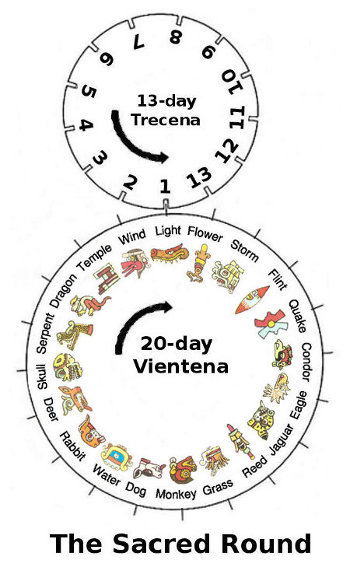 |
The Sacred Round has two independent day counts which each continue uniformly without variation. The first is the "trecena" (Spanish for "group of 13"), which is a continuous 13-day count, much like the week is a continuous 7-day count. Even as the 7-day week has its own calendar (Priest Calendar) so also there is a Trecena Calendar just to keep track of the 13-day cycle.[4]
All that is needed to understand about the Trecena Calendar for this article is that the days are all simply numbered from 1 to 13, over and over. It is illustrated by the top wheel in Figure 4. There is a way of naming each trecena, with 20 different names. Then one group of 20 trecenas forms one Sacred Round of 260 days (20 x 13 = 260). That's was a Sacred Round is, a bundle of 20 trecenas.
There are two points to understand for this article. First, the holy days of a trecena are the first and last, being days 1 and 13. Secondly, in one sense, the beginning day of each trecena is day 13, which acts as a "zero" day as discussed above. That is the day for which the trecena is named, much like the week being named for the priest beginning on Saturday, the zeroth day of the week.
Now consider some more arithmetic. The 91 days in each quarter of the UE Calendar just happen to equal exactly 7 trecenas. That is 91 = 7 x 13. So there are 13 weeks in every quarter and also 7 trecenas.
The holy days of a week are days 7 and 1, the holy days of a trecena are days 13 and 1, and the holy days of a UE quarter are days 0 and 1 at the seasonal markers. Thus, to align all of those together, we get that the day 0 Spring should fall on a day 7 of the week (Saturday) and also 13 of a trecena. The next day would then be 1 Spring, being a Sunday and also day 1 of a trecena. That gives two holy days in a row every quarter on three different sacred calendars. It also fits that the Lord says his house is a house of order (D&C 132:8).
In picking this correlation, just to maximize alignments, note that the trecena is already locked firmly in history, as well as is the day of the week. In other words, by making this choice any day that is a Saturday 13 (trecena) will always be day 0 of a quarter on the UE calendar. That point must be emphasized, because there will be very many sacred events which fall on holy days on the UE Calendar, and the reader should understand that these days are already locked into existing cycles.
Now let us turn to the other cycle of the Sacred Round, which is called the "veintena" (Spanish for "group of 20"). Even as the week of 7 days and trecena of 13 days are continuous day counts, so also is the veintena a continuous count of 20 days. In this case, there are named pictures that go with each day, rather than a number. My translation of the names and the Mixtec glyphs (pictures) are shown in the lower wheel of Figure 4. They both count successively together, so that the day 13 Flower is followed by 1 Light and then 2 Wind. It takes 13 x 20 = 260 days to get back to the starting position, which is the length of the Sacred Round.
The name of a trecena is given by the picture that falls on the day 13 that begins it. For example, the first trecena of the 260-day Sacred Round is named "Flower" because it begins on 13 Flower (like a zero day) with the first official day being 1 Light.
From the discussion above of aligning with the trecena, it was proposed that it is best to align Saturday 0 Spring with a day 13, so that the zero-day of the trecena matches the zero day of the year, and hence 1 Spring would fall on day 1 of the trecena.
That choice means that every quarter will start that way. The only choice left is which particular trecena will be 1 Spring, as opposed to 1 Summer, or the other seasons.
Again, let's look at how often the cycles repeat to see what the choices are. The arithmetic again tells us that 7 Sacred Rounds of 260 days exactly equals 5 UE years of 364 days (7 x 260 = 5 x 364 = 1,820 days). That means that once we choose a starting point on one glyph of the veintena, then only 4 others will ever also be year bearers. And again, the glyph should also be on the day 13 because that is the glyph which names the trecena and we are aligning with the trecena also. If one looks at the math a little more it is clear that of the 20 days in the veintena, 5 will be used for 0 Spring, five for 0 Summer, 5 for 0 Autumn, and the other five for 0 Winter. But which is which?
The question at hand is which set of the five glyphs from the veintena should be chosen for 0 Spring, to herald the Uniform Enoch year? To answer that, it is time to look a little more at the symbolism presented recently about how the Venus Calendar aligns with the Sacred Round. Look at Figure 5.
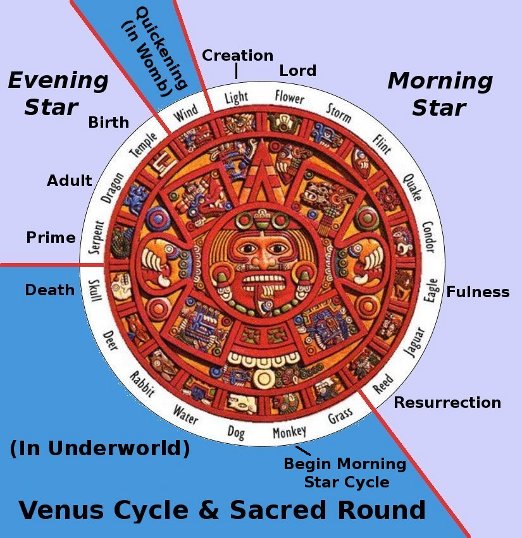 |
Look at the cycle of the twenty days of the veintena in the circle. It divides exactly in half, with the ten on the left being the Evening Star phase and the ten on the right the Morning Star phase. The point for this article that was not mentioned previously is that the first day of the Morning Star phase is the day Monkey. It occurs two days before Reed (Resurrection) even as Light is two days before Temple (Birth). It is an amazing symbolic cycle with much deeper information than we have understood.
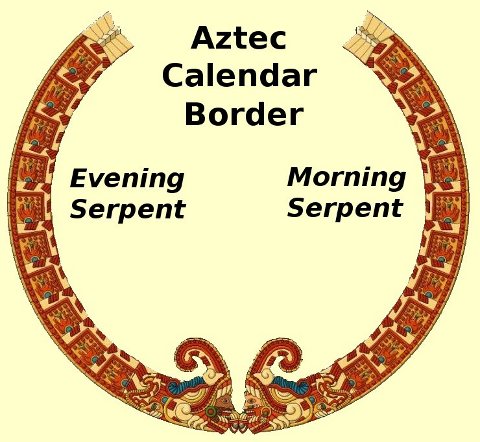 |
Figure 6 shows the two serpents that form the border of the Aztec Calendar (click on it to see the entire calendar). They symbolize evening (dark) and morning (light). Notice that the one on the left (the Evening Serpent) has the dark faced man in the mouth of the rattlesnake. In contrast the rattlesnake on the right has the light-faced man in its mouth. This corresponds perfectly to the entire left side representing the evening half of the full cycle (beginning on Light) and the right side the morning half, starting on Monkey (see Figure 5 again).
The symbolism works for the UE calendar, but it is even better for the Venus Calendar for two reasons. First, each "half" cycle is really a full cycle of its own (like Evening Star) and has an entire serpent to represent it. Secondly, the two serpents are facing each other rather than being head-to-tail. That is exactly how the Venus cycles work, with the two parts of the cycle where Venus is brightest (the heads) facing each other, and as do the two dim parts (the tails).
A big clue that this entire approach is on the right track is that the method of aligning with the Sacred Round (with 0 Spring on 13 Monkey) has identical results with the approach of aligning 0 Spring on 1 Chief of the Priest Cycle. That is, there are dates which aligns all three on the same day. Remember that both the Sacred Round and Priest Cycle are already locked in to historical dates an cannot be moved. So the fact that the beginning day of the UE Calendar can coincide with the first day on two other day counts provides a witness that this method is correct.
At the present time, the best absolute starting point of 0 Spring of the year 0 for the Uniform Enoch Calendar appears to be Sat 3 Feb 4022 BC, which was 13 Monkey. That aligns that year with 1 Resurrection (1 Jachin), and the next year 0 Spring 1 with 1 Chief (1 Jehoiarib) on the Priest Calendar. Now let us turn to the results, which form the next set of witnesses.
Now let us look at what results come from aligning 0 Spring on the Uniform Enoch Calendar (UE) to be on a Saturday, 13 Monkey (SR). They provide a powerful witness that this correlation is correct. It was strong before, but it is much better now because many more sacred events occur on UE holy days.
The result of using the above approach is that pattern of the calendar remains unchanged, but the starting point was adjusted to begin later by two weeks. Years ago when the choice of starting point was being made, there were two choices. One was picked because of alignments on the Firstfruits holy day. Since then, the similar Uniform Jubilee Calendar has been discovered, and it is now clear that those alignments were for the Uniform Jubilee rather than Uniform Enoch Calendar. The result is that even though those dates are no longer holy days on the new UE Calendar, they still are on the Uniform Jubilee Calendar so those are not lost. But many more new ones are gained. My Religious Chronology Summary has been updated to show the new results, most of which simply change holy days that were on Passover (14 Spring) now to be on the spring equinox (0 Spring). Thus they are still on holy days. But let us consider some of the more important consequences of the update. Rather than footnote how all formerly published dates were derived, remember that links to the sources for all of those dates are already available at that Religious Chronology Summary.
.jpg) |
The Savior began his public ministry at age thirty. It turns out that exactly fits the thirty year realignment of the UE Calendar, not just on random days, but on very meaningful days.
.jpg) |
Many years ago in my work, it was published that the time when Mary took Jesus to the temple was on the morning of Sunday 14 May 1 BC. That was 1 Grass (SR), 1 Birth (Mercury), Easter (UJ), and 1 Jeshua (or 1 Savior, P). One point of those articles was that the "Jesus" (Jeshua) priest was presiding.
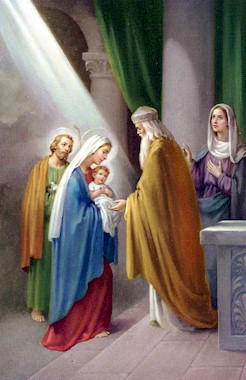 |
The date of the beginning of the Savior's public ministry has been published as being Sat 6 Apr AD 30, being 13 Monkey (SR), Passover (PHC, E), 1 Jeshua (1 Savior P), 0 Fulness (V), 0 Prime (M), and Last Day Passover (UJ). That was plenty to publish before, but now look at the new result. The day was Saturday and 13 Monkey. That means it was also 0 Spring (UE). So these two key events in the Savior's life happened at two ends of the 30-year realignment of 0 Spring (UE), 13 Monkey (SR), and 1 Jeshua (P). So the Jesus priest was again officiating at the temple on the day Jesus began his ministry at the temple, which exactly completed thirty Uniform Enoch years since his Presentation at the Temple. On the Hebrew (PHC) calendar it was his thirtieth birthday (on Passover).
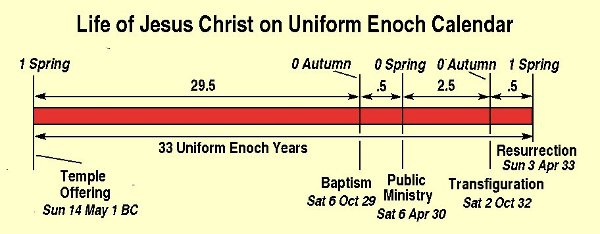 |
Moreover, the dates of the Baptism of Jesus and Transfiguration of Jesus both fell on the autumn equinox, on 0 Autumn. Figure 7 illustrates all of these dates on the Uniform Enoch Calendar. It also shows that it was exactly 33 Uniform Enoch years from the Presentation at the Temple to the Resurrection.
All of the holy days during the life of Christ from the former correlation are still holy days on this new version, but they all fall two weeks earlier (on 0 Spring rather than 14 Spring, meaning on the equinox rather than Passover). But two new holy days appear. The day proposed for the magi's visit to the Savior now falls on Easter (UE) and the death of John the Baptist now falls on Tabernacles (UE), whereas before neither was on a holy day. This is typical: many more new dates are gained than are lost.
 |
But his birth date was nothing special on the Uniform Enoch Calendar until now. It was 28 Autumn, just a normal day. By adjusting the zero point by two weeks, his birth now occurs on 14 Autumn, which is Tabernacles on the UE Calendar. That is another bull's-eye because it is the day representing birth. The odds against that are off the chart!
Moreover, formerly, the day of the Fall of Eve was a holy day, but not the Fall of Adam. That never did sound right. Now they are both holy days, the Fall of Eve being on the equinox (0 Autumn UE), 13 Serpent (SR), and the Fall of Adam on Tabernacles (14 Autumn UE), 1 Storm (SR).
Moreover, the Beginning of Mortality (leaving the Garden of Eden) is now on a holy day starting a quarter, being 1 Summer (UE). Before it was not a holy day.
With the new correlation many more of the ordination dates of the antediluvian patriarchs now fall on holy days. They need not all be listed here, but the summary statement is that before there were two (Jared and Enoch), and now there are six: Adam (14 Aut), Enos (14 Aut), Enoch (0 Aut), Jared (0 Aut), Methuselah (Easter, 15 Spr), and Noah (14 Aut). Notice that the original two have not been lost but are still on the list, so there are four new ones. If the reader is wondering why this was not noticed before, remember that those ordination dates were only discovered within the last two months.
Another point is that the day of Enoch's Blessing by Adam and the founding of his city of Zion on his 65th birthday is now worth publishing. The proposed date is Sat 22 Sep 3313 BC, which was Tabernacles (15 Tis, PHC), his birthday, and also 0 Autumn (E), as was his birthday. It was also Atonement (Jubilee). But now, with this new correlation, it is also 21 Autumn, the Last Day of Tabernacles on the Uniform Enoch calendar. Thus Enoch's special day was holy on both Enoch Calendars.
One more date for Enoch is that now his translation date is a holy day on the UE Calendar: 9 Mid Summer, the fast day equivalent of 9 Ab on the Hebrew Calendar. Before it was strange that Enoch's translation date was not holy on either Enoch Calendar.
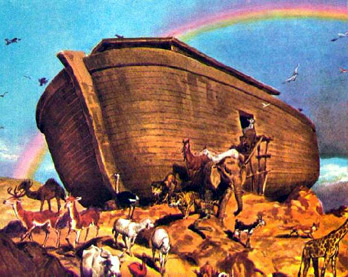 |
One new holy day during the Deluge is the day that it stopped raining after forty days. Before that was not a holy day on any calendar known to me, which seemed strange. All of the other days mentioned during the Great Flood occurred on at least one holy day. Now with the new correlation, the rain stopped on 17 Mid Autumn (UE). That is Deluge Day, the equivalent of 17 Heshvan on the Hebrew Calendar. So the rain started to fall on Sat 16 Nov 2343 BC, Deluge Day (17 Heshvan PHC) and stopped falling on Thu 26 Dec 2343 BC, Deluge Day (17 MAu UE). Hopefully, the reader is seeing how all of these new holy day alignments are forming overwhelming evidence supporting the 14-day change to the correlation.
Another new holy day is that the day the water abated is now Easter (15 Spr UE), rather than being nothing special on that calendar. That day was also Firstfruits (E), 1 Water (SR) and 1 Sivan (PHC), so it was an important day.
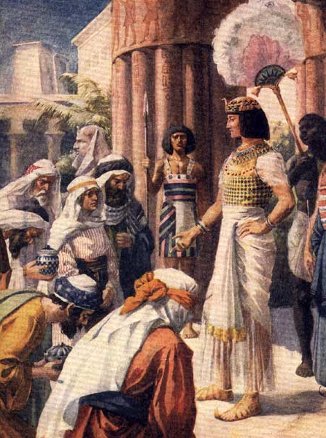 |
Of all the 12 sons of Jacob, only Joseph is born on a holy day on the UE Calendar. He was born on 1 Winter, the first day of the Winter Season. That alone could be just chance coincidence, but he also died on a holy day: Easter (15 Spring, UE).
The significance is increased when on considers what holy days these are. Joseph was born on Easter Sunday on both the PHC and also the Enoch Calendar. So he was born on Easter (E) and died on Easter (UE).
Now the plot thickens as we see the same thing for Joseph Smith. He also is born and dies on holy days on the Uniform Enoch Calendar. He is born on 10 Winter (UE), the fast day corresponding to the fast day 10 Tebeth (PHC). But that is the winter equivalent of his death date on the PHC Calendar 10 Tammuz (PHC, like 10 Summer UE). So he was born on corresponding holy fast days between summer and winter and PHC and UE. That is like Joseph of Egypt. He died on 1 Late Summer (UE).
Moreover, Joseph of Egypt's birth date ties to Joseph Smith. He was born on 1 Winter (first day of winter on UE), and Joseph Smith was born on 1 Tebeth (first day of winter, PHC). So all four of their birth and death dates are holy on the UE Calendar, and they tie to each other and to their own vital dates on the PHC calendar. This really gets tricky, but it is all way beyond chance. This seems to witness that Joseph Smith is indeed the great seer that was promised to be a descendant of Joseph of Egypt (2 Nephi 3:6).
Several new holy dates appear during the time of Moses. First of all, in the last article about the Uniform Venus Calendar, it was noted that Moses' parents Amram and Jochebed were born on a UV holy day, and that Levi's death also occurred on a UV holy day. Now it turns out both of those same days are also holy days on the UE Calendar, with Amram & Jochebed's birth on Passover (14 Spr UE) and Levi's death on the spring equinox (0 Spr UE).
Moreover, much research and reporting went into investigating the meaning of nearly all of the seven chief angels of the Lord having been born during V and UV Calendar alignments. It was decided that Moses was still one of the seven angels even though his vital dates did not follow that rule.
Now a new clue appears. The E and UE Calendars only align with each other every 294 UE years (= 293 Enoch years) for the short period of 5 or 6 years. Guess what! The last year of the 40 in the wilderness lies in that alignment interval. That means that several important holy days were the same on both the Enoch and Uniform Enoch Calendars. For example, the Brazen Serpent day (0 Aut E, UE), and Crossing the Jordan River (Last Day of Passover (E, UE). But the big one for the purpose of the seven angels investigation is that the translation date of Moses was the same on both the U and UE Calendars. Thus, if the hypothesis in the last article had been that all seven angels would either be born or die during periods when the V and UV Calendars, or the E and UE Calendars aligned, then the result would have been in the affirmative without appeal to Moses family pleading for him. There is so much yet to be discovered.
Other dates on UE holy days during the life of Moses are that the manna began on Sunday, 1 Spring (UE) and 1 Chief (Jehoiarib, P), so it was on a New Year's Day (UE) which lined up with the beginning of the Priest Calendar. That was one of the criteria spoken of at the first which seemed important to allow to be possible. Thus, that day when the manna began was truly a starting point, not just of a week, but at least of a 6-year cycle. The day of arriving at Sinai two weeks later was Easter Sunday (15 Spring, UE).
Several dates during the reigns of David and Solomon now fall on holy days on the UE Calendar. To begin with, David's birth occurs on Tabernacles, 14 Autumn (UE), the very day symbolic of birth. Moreover, the day proposed for him being crowned King of Israel falls on Passover, 14 Spring (UE).
During the reign of King Solomon, the day on which the priests begin their service falls exactly on one of the alignment days arranged in this correlation. It is on 0 Spring, which falls on 1 Chief (1 Jehoiarib, P). Then the dedication of the temple two weeks later falls on Passover (14 Spring, UE). Before that was not on a holy day. Remember that this date is specified as the Feast of Tabernacles in the Bible. It was a date already published, so these new alignments are definitely meaningful.
A new correlation of the Uniform Enoch Calendar (UE) was derived from aligning that calendar with three other uniform day count cycles: the Priest cycle and the two cycles of the Sacred Round (SR), the trecena and the veintena. Aligning 0 Spring (UE) to fall on Saturday, 13 Monkey (SR) automatically allowed alignment with 1 Chief (1 Jehoiarib), the beginning day of the Priest cycle. That changed the correlation to be two weeks earlier than formerly believed. That is, events that fell on Passover (14 Spring) on the former correlation now fall on the Spring Equinox (0 Spring).
It was then shown that many more sacred dates in history fell on holy days using this new correlation, including in the lives of Adam, Enoch, Noah, Joseph, Moses, David, and Jesus Christ. My Religious Chronology Summary has been updated to reflect the new dates on the UE Calendar.
The number of holy days is so great that it clearly indicates that this is indeed a sacred calendar that is being used by the Lord to time many key religious events of history.